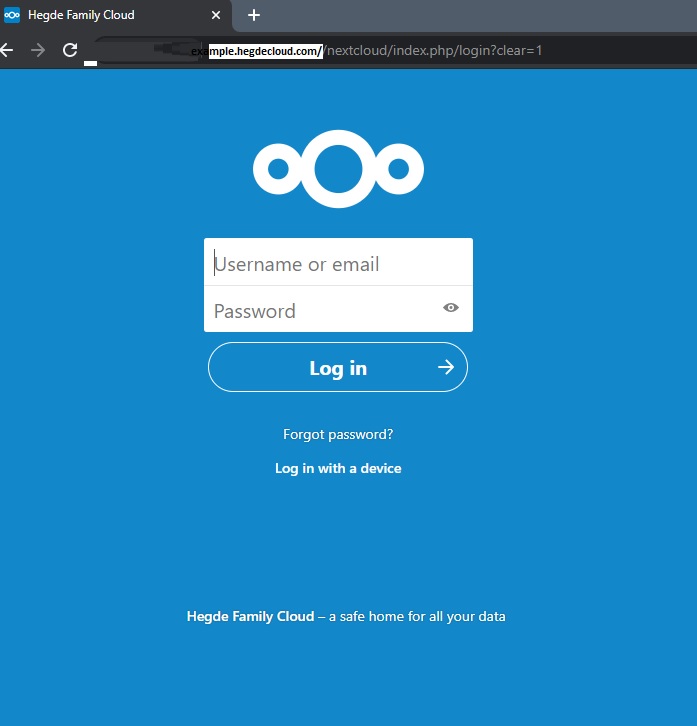Last Updated on May 31, 2023 by Shivanandana Hegde
This post will explain how I turned my old laptop into a home photo cloud storage.
Running out of free photo cloud storage? Worried about your photo privacy? Eventually, we all will be.
Note: The most robust way of setting up your own cloud is obviously to have a proper server at home or at least a NAS system. This involves investment and maintenance costs. However, my goal here to turn an old laptop or PC into my own photo cloud.
Keeping that in perspective, this is by far, the easiest, most practical, free and working solution if you want to create your own photo cloud for personal use at home.
The best part is that it not only works for photos but also works for any file type! So, needless to say, if you want to get entrepreneurial with this, it can be easily scaled to a small business offering too!

Reader’s discretion: You should have the minimum technical skill and conceptual understanding of hosting, server operations, and database. If you are new to all these or just getting started on the technical front, this post might not make much sense to you!
Why should you set up your own photo cloud at home?
- Why setup your own cloud storage at home?
- Cloud Privacy concerns
- Ever increasing cloud storage cost
- Cloud makeshifts
Steps needed to turn your old laptop to own cloud at home
- Pre-requirements to setup cloud at home
- Linux Operating System
- Linux – LAMP is the Goat!
- Cloud Server Platform (at home)
- Cloud Client (on end points/hand held devices)
- Why you should not setup your own cloud?
- Other Considerations
Pros of creating a self-hosted photo cloud: Why create your own cloud at home?
1) Privacy of your data on cloud storage

Cloud privacy is already a hot topic. Therefore, I don’t have to go into great detail on privacy of your personal photos and files.
The best part of setting up your own cloud at home is that you “completely” own your data.
Of course your laptop will be prone to outside attackers just like every other connected device on this earth.
However, if you do a bit of initial work to safeguard it like disk encryption and firewall protection coupled with authentication, your data should be virtually untouchable!
2) Increasing cloud storage cost

Have you observed the trend in cloud storage lately? For instance, take Google Cloud as an example.
During their early stage (i.e., 2008-209), they promised ‘unlimited storage’ to get customers onboard. After few rough years and privacy hurdles, at present, you get about 15GB of ‘free’ cloud storage per account.
Also, google photos & videos were ‘unlimited‘ too. Now, there are constrains like you can’t upload full HD pics & videos etc. Also , it will count towards your cloud storage limit.
Amazon, Apple and Microsoft were always pushing their customer to pay for storage.
It is just a matter of time before you either run out of “free” space or everybody starts charging some recurring fee in near future.
Of course, there are cheap, ‘one-time-payment-only‘ cloud storage options but most of them are so shady. I mean, who knows where it is actually hosted or what happens when they get broken in to?

3) Cloud is inevitable – Free services are just makeshifts

We are already living in the ‘future’ of yesterday. Too cliché? I mean, almost all the apps and storage are already cloud based!. At some point, sooner rather than later, we’ll all end up using cloud more than we ever imagined. Having at least a small size, mini-cloud at our home seems more inevitable than sensible.
Pre requirement to install your own photo cloud hosted at home:
Linux Operating system (Recommended)
When it comes to ‘cost-effective’ server side operations like hosting, Linux is the undisputed king in my personal opinion. Although, everything that’s possible on Linux is also possible on Windows, Linux is my recommended choice keeping stability and long term sustainability in perspective.
Recommended OS: Ubuntu LTS

Best way to install ubuntu?
- The first and best option to is having a stand-alone Ubuntu LTS OS installed on a laptop meant to be your cloud. Even dual booting is pretty solid option.
- Second and slightly risky but more flexible option is to have a Virtual machine running on host OS with Ubuntu as guest OS.
- Thirdly, if you don’t want to do with installation at all, Windows provides virtualization and Hyper-V option called WSLL (now version2) option to run Ubuntu.
- This is the easiest option but needs more technical skill set. Also, I’ve given up on this because it is extremely hard to bridge the network between host and guest OS and maintain a static IP address.
IMPORTANT: Once you set up your cloud, you’ll be dependent on it. It will have all of your files and photos. Therefore, you can’t simply reset everything or allow the system to crash. Test your setup several times and plan for regular backups.
2) Hosting Server and Database to support your own photo cloud hosting
There are plenty of options for both Windows and Linux to install servers and database.
On Ubuntu, get the LAMP!
Recommended for Linux: apache2 (http), PHP and MariaDB database (mysql)

Note: Additionally, you should know how to open ports (aka port forwarding) if you plan on accessing your cloud from anywhere in the world.
You don’t have to worry about port forwarding if you strictly plan to keep own cloud on your home network only.
3) Server side Cloud management platform.
Once your own photo cloud server is up and running, you need a cloud platform (basically that does file management, manages accounts, logins and app-syncing etc.). Your next step would be to install a cloud platform on your server.
Recommended cloud platform: Nextcloud.

- Nextcloud is an open source platform. It widely trusted by several users. Also. it is free and has full package. The best part is it has apps & add-ons too.
- The detailed instructions on it’s installation, user creation and administration can be found here.
- Once you complete the installation, your cloud should now be accessible from web interface.
- For example: your local IP http://123.456.789/nextcloud should now open up a nextcloud’s login.

Actually, you’re almost done at this point. 🙂
NOTE: There is an alternative platform called ‘owncloud‘ which is created by creators of nextcloud. However, it is ‘claimed’ to be a much improved and easy version. I personally didn’t like few technical constrains. Nevertheless, if you just want to give this a try just to get the feel of your own cloud at home, I recommend it. Go for it!
4) Client side App/software — For multiple device Sync and to upload photos to your own cloud
So, now you have files but it should be in sync and accesable to all your devices. So you need a client software or App.
There are pretty good software just to do that. In fact, nextcloud has it’s own Apps:
So, in the nutshell, I am somewhere away from my home. >> I have my cloud setup at home and it is connected to internet. >> I click a photo on my mobile. >> The pic is uploaded to my personal cloud. So, my photo is in my own cloud now!
What are the Cons on a self hosted photo cloud?
Why you should not create and host your own cloud at home?
- Own Cloud Maintenance: You need at least medium to advanced level of technical skill and platform understanding to set all this up. Trust me on this. Even with technical knowledge, it could be a hassle at times.
Needless to mention, it requires maintenance at times. For example, if your login doesn’t work, can you reset it? Basically, you’re on your own! - Security: When you open your PC ports for public access, there are obvious security concerns. — You should also understand how firewall and NAT connections work in addition to installation knowledge.
- Physical damage risks.
The best thing about service providers like Google amazon and Microsoft is that they have constant maintenance and data backup. If you things on your own, you should be diligent on saving it too.
For instance, a physical damage, theft or lost of your laptop can cost you all of your data. So, be prepared to regularly back it up on an external media like hard disks.
Further Considerations:
Data Encryption – It is best to encrypt the disk used for data storage.
SSL – https:// traffic not only support secure transfer of data but also, avoid the ‘Not Secure’.
Proof is in the pudding. Watch my own cloud in action.
Do you have any other cloud platform recommendations? Please comment below.
ALL THE BEST FOR YOUR OWN CLOUD HOSTING!! ?
You may also like reading: How to upgrade laptop processor from i3 to i7 ?

